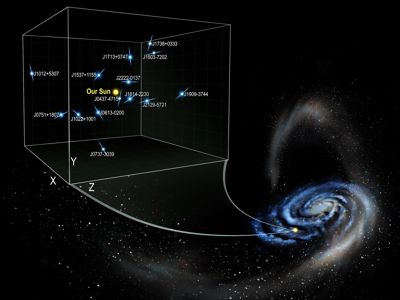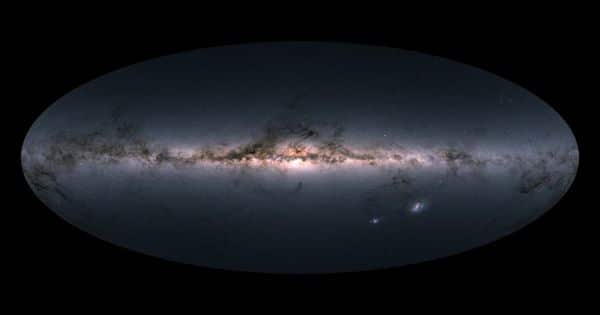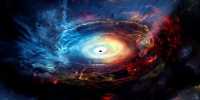Researchers have used pulsar experiments to help learn new knowledge about the abundance of dark matter in our home galaxy. In a new study, led by the Rochester Institute of Technology Associate Professor Sukanya Chakrabarti, to be published in the Astrophysical Journal Letters, researchers have now obtained the first direct measurement of the average acceleration taking place in the Milky Way.
It is well known that the expansion of the universe is accelerating as a result of unexplained dark energies. Stars also undergo movement inside galaxies, and this is due to a mix of dark matter and stellar mass. In a recent report to be published in the Astrophysical Journal Letters, researchers have now obtained the first precise calculation of the average acceleration taking place in our home galaxy, the Milky Way. These calculations will guide the direct detection of dark matter experiments carried out in laboratories around the world.
First direct measurement of the average acceleration taking place within our home galaxy. Based on these new high-precision measurements and the known amount of visible matter in the galaxy, researchers were then able to calculate the Milky Way’s dark matter density without making the usual assumption that the galaxy is in a steady-state.
Led by Sukanya Chakrabarti at the Center for Advanced Research with collaborators from the Rochester Institute of Technology, the University of Rochester, and the University of Wisconsin-Milwaukee, the team used pulsar data to clock the radial and vertical acceleration of the stars within and outside the galactic plane. Based on these recent high-precision measurements and the known volume of visible matter in the galaxy, researchers were then able to determine the dark matter mass of the Milky Way without the normal presumption that the galaxy is in a steady state.

Milky Way’s Dark Side Revealed by Measurements of Pulsar Acceleration
“Our analysis not only gives us the first measurement of the tiny accelerations experienced by stars in the galaxy, but also opens up the possibility of extending this work to understand the nature of dark matter, and ultimately dark energy on larger scales,” stated Chakrabarti, the paper’s lead author and a current Member and IBM Einstein Fellow at the Institute for Advanced Study.
Stars are hovering around the world at hundreds of kilometers per second, and this analysis shows that their velocity is changing at a literal slow pace—a few centimeters per second, which is around the same speed as a crawling infant. To detect this slight motion, the research team focused on the ultra-precise time-keeping capabilities of pulsars that are widely scattered around the galactic plane and halo—a dispersed spherical field that surrounds the galaxy.
“By exploiting the unique properties of pulsars, we were able to measure very small accelerations in the Galaxy. Our work opens a new window in galactic dynamics,” said co-author Philip Chang of the University of Wisconsin-Milwaukee.
Extending about 300,000 light-years from the galactic center, the halo may offer valuable insights into dark matter, which accounts for around 90 percent of the galaxy’s mass and is heavily concentrated above and below the star-dense galactic plane. Stellar motion in this specific region—the primary subject of this study—may be affected by dark matter. Using the local density measurements obtained from this analysis, researchers will now have a clearer understanding of how and when to look for dark matter.
Although previous studies have assumed a state of galactic harmony in order to measure average mass density, this study is focused on the normal, non-equilibrium state of the galaxy. This may be analogized to the contrast between the surface of the pond before and after the stone is thrown in. The team was able to obtain a more realistic view of fact by allowing for the “ripples” But in this situation, rather than stones, the Milky Way is affected by a tumultuous background of interstellar mergers and tends to be disrupted by external dwarf galaxies such as the Small and Wide Magellanic Clouds.
As a result, the stars do not have smooth orbits and appear to follow a course close to that of a distorted vinyl album, traveling above and below the galactic plane. One of the key factors that made this direct observational approach possible was the use of pulsar data compiled from international collaborations, including NANOGrav (North American Nanohertz Observatory for Gravitational Wave) which collected data from the Green Bank and Arecibo telescopes.
“For centuries astronomers have measured the positions and speeds of stars, but these provide only a snapshot of the complex dynamical behavior of the Milky Way galaxy,” stated Scott Tremaine, Professor Emeritus at the Institute for Advanced Study. “The accelerations measured by Chakrabarti and her collaborators are directly caused by the gravitational forces from the matter in the galaxy, both visible and dark, and thereby provide a new and promising window on the distribution and the composition of the matter in the galaxy and the universe.”
This exclusive paper would allow for a wide range of potential research. Accurate acceleration measurements will also soon be possible using the complementary radial velocity method developed earlier this year by Chakrabarti, which calculates the difference in the velocity of stars with high precision. This work would also allow more comprehensive simulations of the Milky Way, improve restrictions on general relativity, and provide hints in the quest for dark matter. In the end, extensions of this approach can allow us to calculate cosmic acceleration directly as well.
Though a clear image of our home galaxy-similar to those of the Planet captured by the Apollo astronauts-is not yet feasible, this analysis offered important new information to help imagine the complex organization of the galaxy from within. This work would also allow more comprehensive simulations of the Milky Way, improve restrictions on general relativity, and provide hints in the quest for dark matter. In the end, extensions of this approach can allow us to calculate cosmic acceleration directly as well.















